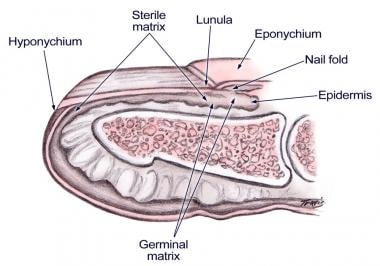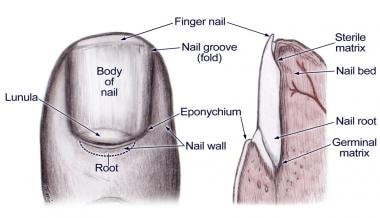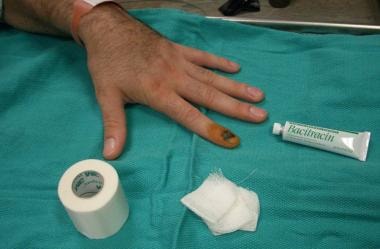Overview
Subungual hematomas are common nail bed injuries caused by blunt or sharp trauma to the fingers or toes. [1, 2] Bleeding from the rich vascular nail bed results in increased pressure under the nail and can cause significant discomfort. [3] Subungual hematoma drainage, also known as nail bed trephination, can be performed to relieve this discomfort. [4]
For information on various nail pathologies, see Medscape article Nail Pathology.
Anatomy
The perionychium is the tissue on each side of the nail, and the eponychium is the skin immediately proximal to the nail. Beneath the eponychium lies the germinal matrix; its distal portion, or lunula, is visible under the proximal nail. The germinal matrix generates most of the nail, while the more distal sterile matrix adheres the nail to the nail bed and assists with nail migration. Injury to the germinal matrix may lead to permanent nail loss. [5, 6] Nail bed anatomy is depicted in the images below.
For more information about the relevant anatomy, see Nail Anatomy.
Indications
Subungual hematoma drainage is indicated in the presence of a painful subungual hematoma with the nail edges intact. [5]
Contraindications
If nail removal is indicated to explore for complex nail bed lacerations (eg, if nail edges are disrupted with a deep laceration), subungual hematoma drainage is not indicated. Most simple nail bed lacerations, however, do not require nail removal and laceration repair. [7, 8]
Subungual hematoma drainage is not necessary if the hematoma is not painful. If blood is spontaneously draining from the hematoma, drainage is also unlikely to be of additional benefit.
In the presence of acrylic nails, electrocautery is contraindicated until the acrylic nail is removed. (Acrylic nails may be flammable, which is of concern if an electrocautery tool is used. [9] ) However, needle trephination can still be done if desired.
Of note, previous sources have recommended nail bed trephination only for subungual hematomas smaller than 25-50% of the nail surface. Recent studies have shown that hematoma size or the presence of underlying distal phalanx fractures do not result in a difference in complications. Therefore, nail bed trephination may be indicated for hematomas of any size if the nail edges are not disrupted. [10, 11, 12, 13]
Anesthesia
Subungual hematoma drainage does not usually require routine anesthesia. A digital block may be considered for pain control but is typically not necessary for the procedure itself. For more information, see Local Anesthesia and Regional Nerve Block Anesthesia.
Equipment
Options for the tool for nail penetration include the following:
-
Needle, 18 gauge (ga) ideal
-
Electrocautery tool (see image below)
-
Paper clip and sterilizing flame
Other possible equipment includes the following:
-
Povidone-iodine solution (Betadine)
-
Nonsterile gloves
-
Gauze
-
Topical antibiotic (eg, bacitracin)
-
Finger splint (optional)
The image below depicts the equipment for this procedure.
Positioning
The patient should be resting with the finger in a position of comfort on a supportive surface (see image below).
The clinician should sit in a position of comfort on the side of the injury.
Technique
Prepare the finger with povidone-iodine solution (Betadine). See the video below.
Using the preferred tool for nail penetration, make a hole at the base of the nail or in the center of the hematoma. This hole must be large enough for the hematoma to drain.
If using an 18-ga needle, twirl the needle between the thumb and index finger with slight downward pressure until no resistance is felt and dark blood return is seen from the hole. See the video below.
If using a paper clip, first heat the end of the paper clip in open flame. Apply the hot tip to the nail until resistance is no longer felt and blood return is seen.
If using a sterile cautery tool, activate cautery until the tip is hot. Apply the tool to the nail as with a heated paper clip.
Allow the hematoma to drain. Gentle squeezing at the tip of the finger may facilitate hematoma drainage.
Apply antibacterial ointment (eg, bacitracin) over the trephination site and dress the wound with gauze or an adhesive bandage. See the video below.
Apply a finger splint for additional comfort. Instruct the patient to avoid soaking the finger and to keep the finger dry for 2 days.
Pearls
When using cautery or a heated paper clip, apply gentle pressure with repeated, quick motions until blood drainage is observed. Applying prolonged constant pressure with heat can result in pain and/or burns.
When appropriate, take a radiograph of the finger to rule out an underlying fracture that may require splinting.
Always check for the presence of an associated extensor tendon injury.
Hematomas that are larger than 50% of the nail do not necessarily require nail removal and exploration. [7, 13]
The nail may fall off during the week following hematoma drainage but should regrow as long as the germinal matrix is intact. [14]
Multiple holes may be necessary to facilitate adequate drainage.
Drainage of the subungual hematoma does not accelerate healing or prevent infection.
If the heat of an electrocautery device is painful for the patient (which is not typical), an 18-ga needle should instead be used for trephination.
Complications
Injury to the nail bed can result if the nail penetration tool is advanced too deep. [15]
Infection may occur if bacteria are introduced into the trephination site during the procedure.
Ineffective drainage may result if the trephination hole is not large enough.
Questions & Answers
Overview
What is the clinical anatomy of the nail bed relevant to subungual hematoma drainage?
When is subungual hematoma drainage indicated?
What are the contraindications for subungual hematoma drainage?
What is the role of anesthesia in subungual hematoma drainage?
What equipment is needed to perform subungual hematoma drainage?
How are patients positioned for subungual hematoma drainage?
How is subungual hematoma drainage performed?
What are clinical pearls for subungual hematoma drainage?
What are complications from subungual hematoma drainage?
-
Equipment.
-
Positioning of finger.
-
Cautery tool.
-
Nail bed anatomy figure 1.
-
Nail bed anatomy figure 2.
-
Preparation of finger.
-
Trephination with needle.
-
Posttrephination care.










